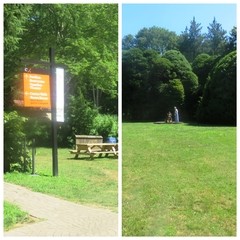|
Back
A Pair of “Schus” Strolling in the Elegant Gardens New York
Katonah (Caramoor Center for Music and the Arts, Venetian Theater)
07/08/2018 -
Robert Schumann: Fantasy in C Major, Opus 17
Franz Schubert: Piano Sonata in B-Flat Major, D. 960
Marc-André Hamelin (Pianist)

M.-A. Hamelin in Caramoor’s Venetian Theater (© Samuel A. Dog)
“Nothing in life is necessary except a garden and a library”
Marcus Tullius Cicero (106 B.C.-43 B.C.)
As well as areas for music, another Cicero essential. Amidst the endless gardens, the verdant foliage, a gorgeous house and areas for experimental ambient sound, the 90 acres of Caramoor have several concert halls. One is in the house of the owner, a businessman-philanthropist. Another, the so-called Venetian Theater, is actually a tent, meant to sit over a thousand people.
Actually, the Venetian’s tent and the stage with faux-Arabesque windows, is relatively unattractive compared to the foliage outside. Those who know Caramoor usually arrive a few hours before the Summer Festival concerts, to stroll through those endless paths, listen to the faint echoes in the “Sound Gardens”–or even slurp a Ben & Jerry’s Ice Cream on one of the emerald-green lawns. (I couldn’t resist what Cicero would have called a “glutton’s extravagance” of chocolate, fudge, marshmallow, mint and unnamable natural and chemical ingredients.)
Come to think of it, those vast lawns are so utterly groomed and dressed, each blade of grass seemingly cut by a licensed manicurist, that a boor like this writer is tempted to drop the Ben & Jerry’s ice cream bucket on the ground to see which endimanché worms screams first. (I didn’t.)
Back to the Venetian Theater, whose attractions are in the soloists. Caramoor had a mammoth supply all through the summer, and I’ll be attending a rare Handel opera in two weeks But this afternoon, it was impossible to resist Marc-André Hamelin. Simply because Mr. Hamelin’s unimaginably wide-ranging repertory vies with his magnificent performance of the so-called classics.
And yesterday afternoon, eschewing the sun and forests and light wind and delight of a cloudless sky, he chose two gigantic works which pictured the human condition. Prayer and marches, sex and chivalry, country-dances, death and transfigurations. In Schumann’s Fantasy–an homage both to Beethoven and Liszt–and Schubert’s final Sonata–an Olympian revel from a young man on the cusp of death–Mr. Hamelin presented a virtual portrait of 19th Century pleasure and passion.
Along with a few minutes of homage to the sunshine. But this comes later.

Entrance and Garden around Venetian Theater (© Samuel A. Dog)
The opening of the Schumann Fantasy was triumph and tragedy. The triumph was the grand symphonic opening, the heaving theme riding over the left-hand semi-quaver figures. The composer prefaced it with a line which could have depicted Mahler or Scriabin–“Sounds of the many-colored earth-dream”. But it was all Schumann. And it was all fantasy. The themes are so beautiful in themselves that nobody demands even a virtuoso pianist to link them together. Thus Mr Hamelin’s changes of tempo and color (with his habitual excusable rubatos) gave the movement a unique wholeness.
(The tragedy was part of an audience whose constant sneezes, wheezes and coughs resonated around the tent. While I doubt if Mr. Hamelin heard them, for us his music had charms to soothe those bronchitic breasts. Except for an airplane and chopper, nothing else interrupted him.)
From then on, Mr. Hamelin played with an assuredness and delight. He is far too tasteful to attempt any idiosyncratic exaggerations, but that taste rarely is finessed. The second-movement march was hardly military, it was lyrical, a naive children’s dream of a march. So much of a dream that one hardly noticed the audacious challenges of the movement coda. Mr. Hamelin sailed through them without a second thought.
Now, though, came the paradox of the afternoon. For the following three movements–the meditative Schumann finale and the first two movements of the Schubert Sonata–Mr. Hamelin repeated those introspective moods thrice over.
Schumann’s finale is complex, has secret underlying strains. Mr. Hamelin played it as sheer meditation, almost as if the composer had been in a trance. Then, following an interval, the opening of Franz Schubert’s B Flat Sonata was offered with that same underlying contemplation.
One can’t confuse history with creation, yet inevitably one should feel, in those buzzing bass trills, something of doom. Yet Mr. Hamelin worked this inanely titled Molto moderato (More moderate??) like a prayer, a consolation rather than an attempt at pathos.
Nor did the following Andante sostenuto actually sustain itself as a contrast. Mr. Hamelin was suitably elegant in what could be a funereal movement. The melody was lovely, the teardrop notes were soft, the major-key middle section had a sensible motorized volition, but the repeated teardrop notes in the treble were less tears than an extended grace note.
One always–always–admires Mr. Hamelin’s playing. Yet in this case, I was relieved to hear these so personal movements, played with such equitable expertise, come to an end. For the third movement opened up Mr. Hamelin’s world to the sunshine. In this case the sunshine of a country dance. Not rollicking but rustic, fun, with a bass-note accent resembling a club-footed dancer trying to keep time. The finale was pure sunshine. The prayerful clouds dissipated, the golden rays of Schubert’s songs were warming, uninhibited, it was the Schubert who had tossed aside his physical woes to allow his (and Hamelin’s) genius full sway.
After these two gigantic works, an encore was uncalled for. But Mr. Hamelin satisfied his audience with Schubert’s A Flat Impromptu, a fitting enough climax for, as always, a fascinating musical adventure.
CODA: Still a few weeks of Caramoor’s pleasures. The compete program can be found at www.caramoor.org/calendar. Without a car, frequent trains leave for Katonah, and a weekend shuttle bus takes visitors to the site.
Harry Rolnick
|